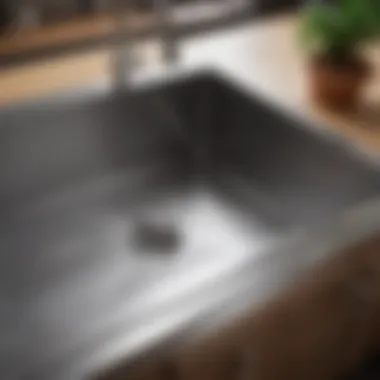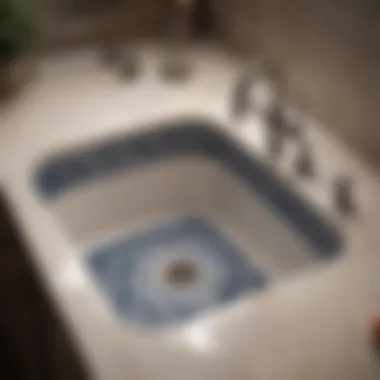Understanding Kitchen Sink Materials for Your Home


Intro
When embarking on a kitchen renovation or even a small-scale upgrade, the choice of sink can be a tipping point in both aesthetic and practical terms. Sinks have transcended their basic functionality to emerge as design statements in contemporary kitchens. Most folks might think, "A sink is just a sink," but the reality is that the material composition plays a crucial role in durability, maintenance, and visual appeal. This article will guide you through an exploration of the materials that make up kitchen sinks, their characteristics, trends, and various considerations pivotal to homeowners.
Design Inspiration
The design of a kitchen sink is often the unsung hero of interior aesthetics. It flows naturally with the overall look and feel of the kitchen, often setting the tone for how space is perceived.
Trending Styles
In recent years, homeowners and designers alike have leaned toward minimalistic and industrial styles. Stainless steel remains a popular choice due to its sleek finish and versatility. More contemporary choices include natural stone and composite materials, which add a unique flair. The farmhouse sink is also making its mark, often called an "apron front", providing both depth and a rustic vibe. Here’s what to consider:
- Stainless Steel: Great for modern kitchens; robust and easy to clean.
- Composite Stone: Perfect for an elegant touch, available in various colors and patterns.
- Ceramic: Offers a classic feel, often with beautiful glaze options.
- Cast Iron: Known for its longevity and traditional feel, though heavier.
When choosing a style, consider how it complements cabinets, countertops, and overall kitchen design.
Color Palettes
The color of your sink can significantly affect the room's mood. Lighter shades can create an illusion of space, while darker hues can add drama and sophistication. Here’s a quick snapshot of current color trends:
- Black and Charcoal: Adds elegance, works well to create contrast with lighter cabinetry.
- White: Timeless, easily pairing with any color scheme, always in vogue for a classic touch.
- Bold Colors: Think deep blues or greens for a pop, turning your sink into a focal point.
Ultimately, the color should reflect personal taste while also fitting harmoniously with the kitchen attributes.
Practical Tips
Selecting a kitchen sink isn't just about looks; several practical aspects warrant attention too.
Maintenance & Care
Different materials require varying levels of care. For instance:
- Stainless Steel: Scratch and dent resistant but can get smudgy. Using a soft cloth for wiping can help maintain its shine.
- Granite Composite: Resistant to scratches but needs periodic sealing to avoid staining.
- Ceramic: Stain-resistant but can chip easily if mishandled.
Developing a consistent maintenance routine can keep your sink looking top-notch and enhance its longevity.
Budgeting & Planning
Setting a realistic budget is essential. Sinks can range from affordable stainless steel models to luxurious handcrafted options. Here's a guideline:
- Budget Sinks: Generally range from $100 to $400, suitable for starter kitchens.
- Mid-Range Options: $400 to $800, often offering better aesthetics and durability.
- High-End Sinks: $800 and above, crafted from premium materials with unique designs.
Don't forget to account for installation costs and any additional fittings that may be needed.
Remember: Choosing a sink that fits your lifestyle and complements your kitchen design ensures satisfaction long after the remodel is complete.
Prologue to Kitchen Sink Materials
Understanding the various materials used in kitchen sinks is crucial for any homeowner or interior design enthusiast. A kitchen sink is not merely a functional element; it plays an integral role in the overall design aesthetic and the practical experience within a culinary space. Choosing the right material reflects personal style, complements other design choices in the kitchen, and influences the sink’s longevity and maintenance needs.
When selecting a kitchen sink, it’s essential to consider the attributes of each material—such as durability, maintenance, and aesthetic appeal. Each type of material interacts distinctively with everyday kitchen activities, from washing dishes to preparing meals. Selecting a sink that aligns with both your functional needs and visual preferences can significantly enhance the kitchen's efficiency and atmosphere.
Particularly for homeowners looking to remodel or enhance their spaces, the evolution of materials and their applications can provide fresh insights into what is possible. Furthermore, as design trends evolve, so do the materials used in these essential fixtures, offering varied options and styles that cater to modern sensibilities while meeting age-old requirements of functionality and durability.


"The choice of sink material can dramatically impact the kitchen’s functionality and charm, leading to a balanced design that sings with style."
This exploration will walk through available materials, the benefits they offer, and tips for making an informed decision about which fits best within the unique ecosystem of your kitchen. By understanding the nuances of different sink materials, homeowners can navigate their options with confidence, ensuring their investment not only meets needs but also enhances their home’s character.
The Role of Kitchen Sinks in Home Design
The kitchen sink is often considered the heart of the kitchen. This statement holds a lot of truth, as it is used daily for various tasks, from food prep to cleaning. Its visibility can make or break the kitchen’s look and function. In modern design, sinks are no longer just practical fixtures; they contribute to the overall ambiance and aesthetic.
When planning a kitchen layout, the sink should harmonize with the surrounding cabinetry, countertops, and appliances. Here's why it deserves special attention:
- Focal Point: The sink can serve as a focal point that draws attention, especially if it features unique materials or finishes.
- Functional Placement: Its location influences the workflow in the kitchen. A well-placed sink enhances efficiency, making meal preparation a breeze.
- Diverse Styles: From farmhouse sinks to sleek, undermount designs, different styles cater to various tastes, ensuring that the sink integrates smoothly into the desired look.
Whether hosting a dinner party or catering to a family’s needs, the choice of sink can elevate and define your kitchen space. With such an essential role, understanding the materials is just the first step towards creating a kitchen that is as functional as it is beautiful.
Common Materials for Kitchen Sinks
When it comes to selecting a kitchen sink, the material makes all the difference. Kitchen sinks are more than just functional elements in our kitchens; they play a significant role in the overall design and durability of the space. With a variety of materials on the market, choosing the right one hinges on several factors, including style, functionality, cost, and maintenance.
- Durability is a primary consideration. Some materials withstand high temperatures and heavy use better than others. Several homeowners have found themselves regretting not placing more emphasis on this aspect when making their initial selections.
- Aesthetic appeal is another important aspect. The sink can become a focal point, and different materials project unique styles. For instance, a polished stainless steel sink can lend a chic, modern vibe, while a rustic cast iron might be better for a farmhouse-style kitchen.
- Lastly, sustainability is gaining traction in material choice. Many people today prefer eco-friendly options that align with their values. Navigating these considerations can feel overwhelming without a clear understanding of each material's strengths and weaknesses.
Let's delve deeper into individual materials to see what each brings to the table.
Stainless Steel: Durability and Modern Appeal
A go-to for many contemporary kitchens, stainless steel is known for its resilience and versatility. The material is resistant to corrosion, stains, and heat, making it a practical choice. This is particularly important in busy households where sinks see daily wear and tear.
Stainless steel sinks have a clean and sleek appearance. They often fit seamlessly into modern designs and work well with various kitchen styles. Maintenance is relatively low; they require simple cleaning with soap and water to retain their shine. However, one should note that they can scratch over time, necessitating a bit of care to keep them looking new. On the downside, they can be noisy, so rubber or silicone mats might be useful to cut down on sound.
Cast Iron: A Timeless Classic
Cast iron sinks are synonymous with durability and traditional aesthetics. Typically coated with enamel, these sinks offer a glossy surface that is appealing to many homeowners. They come in a variety of colors, which allows for customization in design. Their sturdy nature means they can withstand heavy usage without showing significant signs of wear.
However, weight can be a concern. Cast iron sinks are heavy, requiring strong cabinetry to support them. They can also chip if care isn't taken, especially around the edges. Nevertheless, if maintained properly, a cast iron sink can last a lifetime, becoming a centerpiece in the kitchen.
Composite Sinks: Blending Style and Function
Composite sinks are crafted from a mix of materials, often featuring a blend of acrylic and stone. This mix yields a lightweight yet durable sink that resists scratches and stains. Their non-porous surface prevents odor build-up, making them a hygienic choice as well.
The appearance of composite sinks is appealing too. They can be found in various colors and finishes, often mimicking the look of natural stone without the hefty price tag. Their relative ease of maintenance adds to their appeal, although some cleaning agents can be too harsh. It's wise to opt for mild detergents to prolong their good looks.
Fireclay: A Blend of Tradition and Innovation
Fireclay sinks are crafted from a unique mixture that is fired at high temperatures. This process results in a durable, non-porous surface that is resistant to chips and scratches.
They often boast a classic, farmhouse-style appearance that suits both modern and traditional kitchens. However, their weight can be prohibitive, similar to cast iron. Moreover, the need for proper installation is crucial to avoid damage.
Fireclay sinks can also be more costly than other options, but investing in one can elevate the overall appearance of your kitchen significantly.
Granite and Quartz: Sophisticated Elegance
Granite and quartz sinks are made from solid stone materials available in various shades and textures. Known for their luxurious und durability, they add a touch of elegance to any kitchen design. Their resistance to scratching and heat further enhances their desirability.
While they can demand a higher price compared to other materials, homeowners often find them worth the investment due to their aesthetic appeal and long-term performance. Regular sealing may be necessary, primarily for granite, to maintain their beauty and prevent staining.


Copper: Antimicrobial Properties and Unique Aesthetics
Copper sinks appeal to those who appreciate a rustic, weathered look. This material brings warmth and charm into a kitchen. Beyond aesthetics, copper boasts natural antimicrobial properties, making it an excellent choice for kitchen hygiene.
They do require more maintenance than other materials since copper can patina over time. Some homeowners appreciate this change as it adds character, while others prefer to keep up with regular polishing to maintain the original shine. The key is ensuring you know what you're getting before making a decision.
In summary, the material you choose for your kitchen sink should reflect your lifestyle needs, aesthetic preferences, and values surrounding sustainability. Each option offers something unique, ensuring there's a perfect fit for every kitchen style.
Factors Influencing Material Selection
Choosing the right material for kitchen sinks is not just a matter of preference; it’s a meticulous balancing act of cost, aesthetics, and longevity. Homeowners today find themselves at a crossroads, where the convergence of style, functionality, and maintenance all dictate the final decision. Let's explore these factors in detail, providing a lens through which we can understand what drives the selection process.
Cost Considerations: Budgeting for Excellence
When it comes to kitchen sink materials, cost consideration can’t be swept under the rug. Each material carries its own price tag, which plays a pivotal role in the selection process. For example, stainless steel sinks are generally more affordable and accessible than their copper or fireclay counterparts. These options not only offer durability but come with a less overwhelming price point, making them appealing to budget-conscious homeowners.
However, it’s essential to realize that a higher initial investment might yield long-term savings. For instance, while a cast iron sink may cost a pretty penny up front, its resilience and ability to withstand wear and tear can translate to fewer replacements over the years. Therefore, finding the sweet spot between initial cost and long-term value is key when budgeting for kitchen sink materials.
Aesthetic Preferences: Matching Style with Material
Style is where personal expression truly shines. The kitchen often serves as the heart of the home, and the right sink can elevate its design. Consider those who favor a rustic vibe; composite sinks may provide that earthy, natural look while maintaining practicality. On the other hand, modern minimalists might gravitate towards the sleek, clean lines of stainless steel or the elegant shine of copper.
It’s equally important to think about the finish and surface texture, which can drastically alter the sink's look and feel. Matte finishes tend to hide scratches better than glossy options, while vibrant colors can make a strong design statement. The key here is to ensure that the chosen material harmonizes not only with the kitchen’s overall aesthetic but also with the preferences of those who use it daily.
Durability and Maintenance: Long-Term Viability
Durability can often feel like a buzzword, but in the kitchen, it’s essential. Some materials might wow you at first sight but get easily marked by scratches or stains. Stainless steel is widely known for its strength and resistance to damage, but it’s not perfect; scratches can accumulate over time, requiring careful maintenance to keep it looking sharp.
On the flip side, fireclay sinks stand tall in durability and come with the advantage of being easy to clean. They resist chipping, making them a practical choice for busy kitchens. Yet, heavy-duty doesn’t mean neglect; regular care with gentle cleansers is always necessary to maintain their appearance and performance.
Each homeowner's lifestyle should steer the decision on durability and maintenance. A family with young kids and pets might prioritize resilience, while a single professional might lean towards low-maintenance elegance. Whatever your situation, understanding the long-term viability of sink materials can save you from future headaches.
"Investing in the right kitchen sink material today sets the stage for a seamless cooking experience tomorrow."
In summary, the factors influencing material selection of kitchen sinks encompass several layers of consideration. From crunching numbers to ensuring that style meshes well with functionality, to focusing on durability for the long run, each element plays a significant role in making an informed choice. Every kitchen is unique, and understanding these factors allows homeowners to navigate their options strategically.
Innovations in Sink Technology
The kitchen sink has come a long way from being just a basin to rinse vegetables or wash dishes. In today's world, innovations in sink technology are revolutionizing both functionality and aesthetics, making these fixtures key players in modern home design. Not only are the materials evolving, but also the technologies incorporated into sinks that enhance user experience.
Advancements in Material Composition
Recent advancements in the composition of sink materials have added a layer of sophistication and utility that wasn't available before. For example, manufacturers are now experimenting with materials like titanium-infused ceramics that resist scratches and staining. These innovations ensure that sinks maintain their appearance over time, resisting the wear and tear of daily use.
Moreover, composite materials have improved significantly. With the fusion of acrylic and stone, composite sinks strike a balance between durability and versatility. This makes them not only easier to maintain but also available in a broad spectrum of colors and finishes, matching any kitchen décor.
Some new sinks even utilize eco-friendly materials, which have gained popularity among environmentally-conscious homeowners. Options made from recycled materials contribute to reducing waste without sacrificing aesthetics or functionality.
Smart Features in Modern Sinks
The advent of smart technology in kitchen design has also influenced the development of sinks. Modern sinks can now feature built-in sensors and touchless faucets, adding an extra layer of convenience when hands are messy. These sensors can often detect motion, turning the faucet on or off automatically, making them ideal for busy kitchens where efficiency matters.
Additionally, some innovative sinks come equipped with integrated dishwashers or food processors. This seamless merging creates a multifunctional workspace, effectively combining tasks like washing and food preparation.


Another intriguing feature is the use of LED lights for under-sink illumination, which not only enhances visibility but also adds a stylish aesthetic. These lights can even change color based on water temperature, providing both a visual cue and a bit of flair.
"Innovations in sink technology not only elevate the functionality of kitchen spaces but also push forward the boundaries of design possibilities."
As homeowners continually seek to blend practicality with style, understanding these advancements can help make informed choices that benefit both the aesthetics and functionality of their kitchens. Whether it's the durability of new materials or the convenience of smart technology, the innovations in sink technology are paving the way for an enhanced home experience.
Sustainability and Environmental Impact
In today’s world, where the emphasis on eco-conscious living is stronger than ever, understanding the sustainability and environmental impact of kitchen sink materials has become essential. The way we select our sinks can either contribute to or detract from our efforts to build a more sustainable future. From manufacturing processes to the lifespan of materials, each element plays a role in reducing our carbon footprint. Homeowners and designers alike are beginning to recognize that choosing eco-friendly options is not just a trend; it's a responsibility.
When considering sustainability, the key factors often revolve around the environmental impact during production, the source of materials, and the longevity of the products. An eco-friendly sink not only minimizes waste during its manufacturing process but also offers durable performance that leads to fewer replacements over the years. Sinks made from sustainable materials are designed to withstand the test of time, ultimately conserving resources in the long run. By opting for such solutions, one can contribute to a greener planet without sacrificing style or functionality.
Benefits of Sustainable Kitchen Sinks:
- Reduced Environmental Footprint: Sourcing materials from renewable or recycled sources helps decrease the overall ecological damage.
- Longer Lifespan: Durable materials mean fewer replacements, translating to less waste in landfills.
- Healthier Indoor Air Quality: Non-toxic materials contribute to a safer kitchen environment for families.
"Sustainability in sink selection is not just about materials; it’s about the choices we make that ripple through our communities."
Eco-Friendly Materials and Practices
The selection of eco-friendly materials stems from the need to address environmental concerns head-on. When homeowners dive into options, they commonly come across materials that stand out not only for their aesthetics but also for their environmental attributes. Recycled stainless steel, for instance, provides a sustainable choice as it uses post-consumer scrap, reducing the need for virgin raw materials. Another material gaining traction is composite sinks made from crushed stone and resin. These products often utilize recycled materials, which means less waste and more responsible production.
Practices also play a role in sustainability. Manufacturers increasingly adopt green processes, such as:
- Using non-toxic adhesives and finishes.
- Implementing water-saving technologies during the manufacturing process.
- Reducing energy consumption in manufacturing facilities.
By prioritizing these practices, producers can help minimize their carbon footprints, and conscientious consumers can ensure their kitchen installations contribute to a healthier environment.
The Circular Economy in Sink Production
The concept of a circular economy is pivotal when discussing sustainability. It emphasizes the importance of reusing and recycling materials. In the kitchen sink realm, this notion is beginning to reshape how sinks are produced and disposed of. Rather than following a linear path where products are made, used, and then discarded, the circular economy encourages a cycle of reuse.
Sink manufacturers are exploring ways to design for disassembly, allowing sinks to be easily repaired or upgraded instead of discarded. This approach not only extends the life cycle of the product but also ensures that valuable materials can be extracted and refashioned at the end of their life. Some key components include:
- Reusing valuable resources: Scrap materials from one sink can become the basis for another.
- Resource-efficient designs: Creating sinks that minimize material usage without compromising quality.
- End-of-life strategies: Plans for how consumers can recycle their sinks or even return them to the manufacturer for compliant processing.
Through these practices, consumers can adopt a sustainable mindset that recognizes the importance of maintaining resources and minimizing waste. Entering a cycle where products are continuously updated rather than disposed of leads to a more sustainable and conscientious approach to home design.
Culmination: Navigating Material Choices
Selecting the right kitchen sink is akin to choosing the right frame for a cherished picture; it can truly enhance the overall aesthetic and functionality of your kitchen. As we wind up our exploration of kitchen sink materials, it's essential to focus on several key elements that contribute to making an informed decision.
First and foremost, understanding the properties of different materials—whether it be the modern allure of stainless steel, the classic charm of cast iron, or the sophisticated appeal of granite—opens a world of possibilities. Each material brings its unique benefits and considerations to the table. For instance, if durability is your number one priority, stainless steel might be the way to go. However, if you prefer a timeless touch, you might lean towards the classic cast iron.
When pondering your options, consider your lifestyle too. Are you a cooking enthusiast that often finds flour dusting your counter? Do you have little ones running around, or is your kitchen the social hub for gatherings? Each of these scenarios influences the type of sink that will best serve your needs. A deep bowl sink can work wonders for a home chef, while a slick, easy-to-clean surface could be ideal for busy families.
Additionally, aesthetics play a crucial role. Your sink shouldn’t just be functional; it should resonate with your kitchen's overall style. The trend of combining materials is gaining traction. Pairing a stunning granite countertop with a sleek stainless steel sink can create a striking centerpiece.
Here’s a quick list of considerations to help steer your decision-making:
- Assess your cooking habits; choose a sink that complements your culinary activities.
- Think about the maintenance required; some materials might look seamless but may demand more upkeep.
- Visualize how the sink fits in your kitchen's decor; color, texture, and style should all align.
“A kitchen sink is more than just a utility; it’s a statement about your lifestyle and tastes.”
Key Takeaways for Homeowners
- Material Matters: Different materials provide distinct advantages. Understand them to make a suitable choice.
- Lifestyle Alignment: Align sink choice with your lifestyle to enhance cooking enjoyment and convenience.
- Long-Term Investment: A sink isn’t just a purchase; it's an investment in functionality and style for years to come.
- Innovative Options: Don't shy away from exploring the latest trends in sink features and technology, including smart solutions for busy homes.
- Sustainability Counts: Paying attention to eco-friendly options can benefit both your home and the planet.
By factoring in these considerations, homeowners can navigate their kitchen sink choices with greater confidence, ensuring that they find a solution that fits their needs and enhances their home’s appeal.















